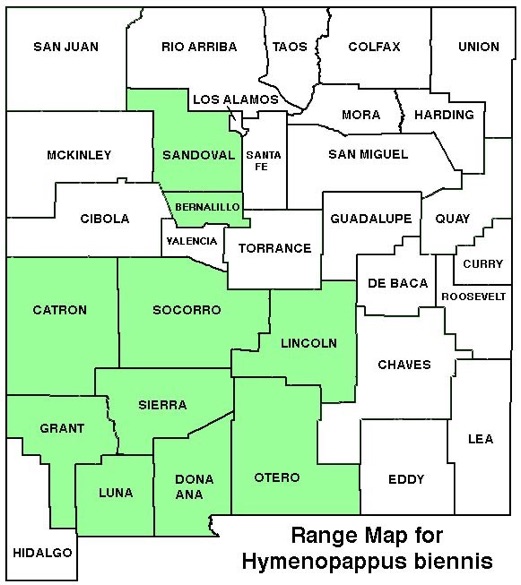WILDFLOWERS OF NEW MEXICO

Each taproot produces a single stem, 24–40-inches tall with numerous branches in the upper portion with 20–40 white flower heads. The numerous white ray flowers, yellow disk, and deeply divided leaves with narrow lobes help identify this common mountain species.
FLOWERS: July–October. Branching stems have numerous flower heads with 8 white, oval rays, each 1/2–5/8-inch (14–16 mm) long, 1/4–5/15-inch wide (6–8 mm), tips with no or only shallow notches; disk flowers yellow aging brownish; phyllaries under the rays broad, knobby, hairy, in a single row.
LEAVES: Basal and alternate on stem, blades deeply dissected with lobes divided twice into narrow segments; basal rosette leaves 2 3/5–6 1/4-inches (6–16 cm) long, thread-like to 1/8-inch (1–3 mm) wide; stem leaves increasingly smaller upward, surfaces sparsely hairy to hairless.
HABITAT: Gravelly loam soils; roadsides, disturbed areas, pinyon-juniper, mountain meadows, spruce-fir forests.
ELEVATION: 6,000–10,300 feet.
RANGE: NM, TX.
SIMILAR SPECIES: The look-alike perennial Wild Cosmos, H. newberryi, through the central and northern mountains of NM, has multiple stems per taproot, each stem with 3–8 flower heads.
NM COUNTIES: The southern half of NM in mid- to high-elevation, moist habitats: Bernalillo, Dona Ana, Grant, Lincoln, Luna, Otero, Sandoval, Sierra, Socorro.

BIENNIAL WOOLLY-WHITE
HYMENOPAPPUS BIENNIS
Aster Family, Asteraceae
Biennial herb

THE CONTENTS OF THIS WEBSITE ARE COPYRIGHTED AND CANNOT BE USED
WITHOUT PERMISSION OF GEORGE OXFORD MILLER



Basal rosette of deeply cut leaves with narrow segments forms first year. A single stem with numerous branches and blooms forms the second year (photo below).
Phyllaries under the rays broad, knobby, hairy, in a single row.

The single stem from a basal rosette often has numerous branches and dozens of flower heads.
EMAIL ME